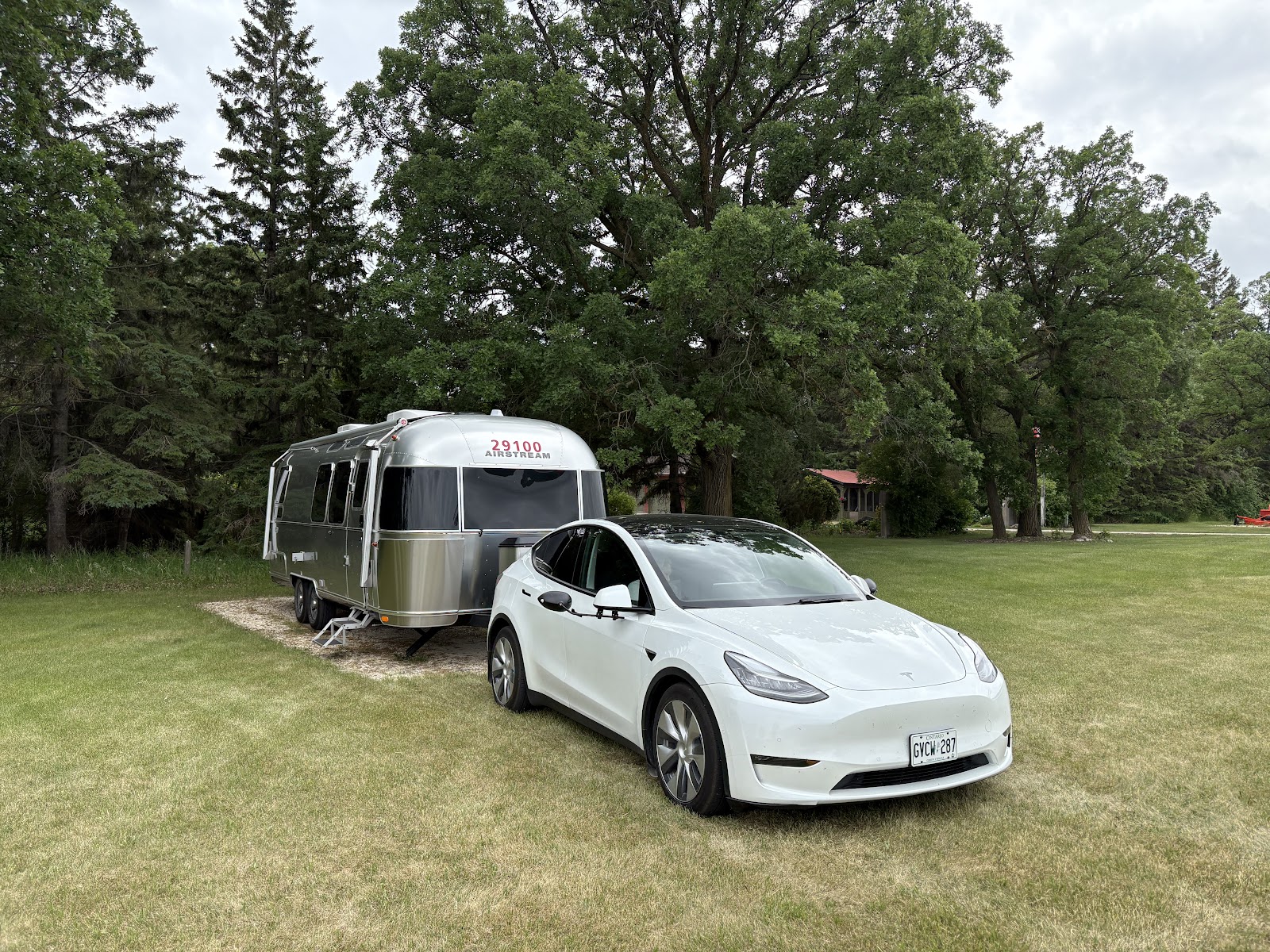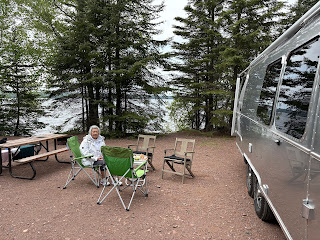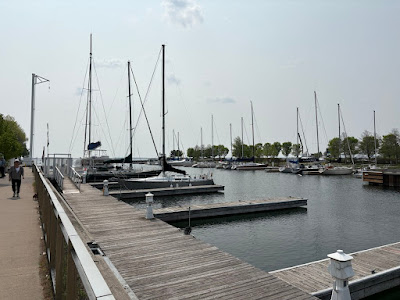Monday, June 16 – Westward to Manitoba
Many friends have asked us about the smoke from wildfires out west. We did encounter a few hazy days along the shores of Lake Superior, but for the most part, the air has been clear. That changed slightly west of Winnipeg, where our Tesla’s air quality index display lit up again—though we still couldn’t smell the smoke or see any visible haze. Still, we’ve both noticed some congestion and a tickle in the throat. There’s rain in the forecast, and we’re hopeful it will help improve the situation.
Leaving Kenora and heading west, the landscape changed dramatically. Gone were the rock cuts and forests—replaced by flat expanses and long, straight roads that barely required a turn of the wheel. We began to see enormous farms stretching to the horizon, dotted with clusters of huge grain elevators and farmhouses sheltered by towering walls of evergreens, planted as windbreaks against the harsh Manitoba winters. The transformation over just 300 kilometres was striking.
 |
| Massive farm operations like this were everywhere |
Here are some fascinating facts about the great province of Manitoba:
The province includes Arctic tundra, boreal forest, and prairie grasslands.
Manitoba is home to more than 100,000 lakes, including Lake Winnipeg—one of the largest in the world.
Churchill is the most accessible place on earth to view polar bears in the wild—and also a prime location to see the northern lights.
Little Limestone Lake, the world’s largest marl lake, changes colour with water temperature.
Manitoba is a cultural mosaic, home to vibrant First Nations and Métis communities, Canada’s largest Ukrainian population, and growing Filipino, South Asian, and Black populations.
The province hosts the largest concentration of red-sided garter snakes in the world. Each spring, they emerge in massive writhing mating balls—sadly (or not?), we missed that spectacle by a few weeks.
Hudson Bay is home to over 25,000 beluga whales, with about 3,000 visiting the Churchill area between mid-June and mid-August.
Wapusk National Park in northern Manitoba holds the world’s largest concentration of polar bear dens.
Winnipeg boasts the sunniest winter in Canada, with 358 hours of sunshine.
To reach our next stop, we needed a charge at a Tesla Supercharger in Winnipeg. After so much time on peaceful rural highways and small towns, entering the city felt like being dropped into a metropolis—narrow roads, potholes, construction everywhere, and all the usual chaos made worse by towing a 28-foot trailer. It was a huge relief to hit the open road again after the charge.
 |
| The streets of Winnipeg - with a 28' trailer attached to us... |
That night, we stayed at our very first Harvest Hosts location: WaterSong Farms, about 40 kilometres northwest of Winnipeg. Owned by Leslie and Rudy Reimer, the farm has been in Leslie’s family for over 60 years. Over the decades, they’ve raised crops, beef, and poultry—but their latest venture is truly remarkable: a state-of-the-art indoor trout farm.
Using a simulated river system, the facility raises steelhead trout in fresh water sourced from a 250-foot-deep aquifer. It’s designed to produce up to 140 metric tonnes of trout annually. Amazingly, 98% of the water is recycled, and the system is completely antibiotic-free. Waste is filtered and used as farm fertilizer. Their trout operation is both Ocean Wise Green Certified and SeaChoice Certified—the gold standard for sustainable seafood.
They also raise two flocks of roasting chickens each year. The whole operation is a model of sustainability, with a clear commitment to protecting the land and supporting the community. We felt fortunate to tour the facilities and hear their story. Leslie and Rudy are now preparing for retirement and will sell the farm and move to Vancouver Island. Before leaving, we picked up some vacuum-packed trout fillets and smoked trout for future meals.
Camping on their beautiful, peaceful farm was a real highlight—so different from a traditional campground and a perfect example of what Harvest Hosts can offer.
 |
| Fran with Harvest Hosts - Leslie & Rudy at WaterSong Farms |
Fran with Harvest Hosts - Leslie and Rudy at WaterSong Farms
 |
| Vacu-sealed Steelhead Trout from WaterSong Farms |
 |
| Our campsite at WaterSong Farms |
 |
| Wide open landscape around WaterSong Farms |
The next day, we made our way to Silver Creek Campground, just east of Brandon, Manitoba. While a few of the secondary roads were rough, once we were back on the Trans-Canada, it was smooth sailing with only one stop needed for charging.
Brandon, known as “Wheat City,” is Manitoba’s second-largest city and a major agricultural hub. It’s home to Brandon University and hosts the Royal Manitoba Winter Fair, the Manitoba Agricultural Exhibition, and various music and arts festivals.
While there, we visited the Commonwealth Air Training Plan Museum—an incredibly well-done tribute to Canada’s role in the British Commonwealth Air Training Plan (BCATP) during WWII. The plan brought together four nations—Canada, Australia, Great Britain, and New Zealand—to train aircrew. At its peak, the BCATP operated 231 sites across Canada, with 107 schools and 184 supporting units. It involved over 10,900 aircraft and more than 104,000 personnel. It’s often called one of the most successful joint military efforts in history.
The museum reminded me of the Warplane Heritage Museum in Hamilton, Ontario which I visited years ago with my father—who served as a flying instructor during the war. He rarely spoke about that time, but during our visit to the Hamilton Warplane Museum, he walked through the hangar, pointing out the planes he had flown and explaining their characteristics. At his funeral, a fellow veteran, Morris Fitzmorris, shared that my dad had trained many airmen—and not one of his students ever crashed. The Air Force, recognizing his skill, kept him in Canada as an instructor throughout the war. As one historian noted, “The flying instructors of the BCATP must be counted among the unsung heroes of the war.”
 |
| Pics of the Brandon BCATP |
 |
| Memorial wall (left) names and pays tribute to all those fallen who served in the air and on the ground, overseas and on Canadian soil |
This memorial wall (on the left) names & pays tribute to all those fallen who served in the air and on the ground, overseas and on Canadian Soil.
After the museum, we took a stroll along Brandon’s lovely Riverbank green space, had a bite of lunch, and then returned to our trailer at Silver Creek.
 |
| Brandon River Park |
 |
| Purple Martin Sanctuary |
It is fair to say both the car and trailer can get quite dirty on long drives like this. Bugs are splattered across the front of the car, the windshield and the front of the trailer. Those who know me won't be surprised that the bugs get cleaned off after each travel day. The car got fully washed at our campsite near Kenora. And yesterday, the trailer got its spa day too.
Tomorrow—onward to Saskatchewan!



































